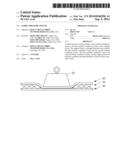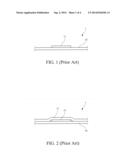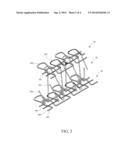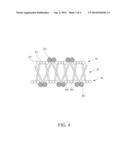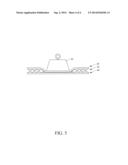Patent application title: FABRIC PRESSURE SWITCH
Inventors:
Hong Hsu Huang (Taipei City, TW)
Hong Hsu Huang (Taipei City, TW)
King'S Metal Fiber Technologies Co., Ltd.
I Chen Su (Taipei City, TW)
I Chen Su (Taipei City, TW)
King Mu Hsiao (Taipei City, TW)
Shun-Tung Yang (Taipei City, TW)
Assignees:
KING'S METAL FIBER TECHNOLOGIES CO., LTD.
IPC8 Class: AH01H1029FI
USPC Class:
200 6114
Class name: Special application running length, web or strand actuated actuator attached to or part of web or strand
Publication date: 2014-09-04
Patent application number: 20140246296
Abstract:
A fabric pressure switch includes a first resilient conductive tissue, a
second resilient conductive tissue, and a support tissue. The support
tissue is arranged between and connects the first resilient conductive
tissue and the second resilient conductive tissue. The first resilient
conductive tissue, the second resilient conductive tissue, and the
support tissue are unitarily combined through knitting to form the fabric
pressure switch.Claims:
1. A fabric pressure switch, comprising: a first resilient conductive
tissue, which is formed by arranging and interlacing a plurality of first
structural yarns, a plurality of first elastic yarns, and a plurality of
first electrically conductive yarns, wherein each of the first structural
yarns is combined with each of the first elastic yarns as a strand for
being alternately arranged with each of the first electrically conductive
yarns; a second resilient conductive tissue, which is formed by arranging
and interlacing a plurality of second structural yarns and a plurality of
second elastic yarns, and a plurality of second electrically conductive
yarns, wherein each of the second structural yarns is combined with each
of the second elastic yarns as a strand for being alternately arranged
with each of the second electrically conductive yarns; and a support
tissue, which is formed of a plurality of first support yarns and a
plurality of second support yarns and connects between the first
resilient conductive tissue and the second resilient conductive tissue,
wherein each of the first support yarns is arranged, as the same strand,
with each of the first structural yarns and each of the first elastic
yarns and extends to the second resilient conductive tissue to be
arranged, as the same strand, with each of second structural yarns and
each of the second elastic yarns and each the second support yarns is
arranged, as the same strand, with each of the first electrically
conductive yarns and extends to the second resilient conductive tissue to
be arranged, in the same strand, with each of the second electrically
conductive yarns corresponding to the first electrically conductive
yarns.
2. The fabric pressure switch as claimed in claim 1, wherein the first structural yarns and the second structural yarns are each one of polyester yarn, porous fiber yarn, alginate fiber yarn, carboxymethyl cellulose fiber yarn, rayon fiber yarn, metal fiber yarn, carbon nanotube fiber yarn, and carbon fiber yarn.
3. The fabric pressure switch as claimed in claim 1, wherein the first electrically conductive yarns and the second electrically conductive yarns are one of metal fiber yarn, carbon nanotube fiber yarn, and carbon fiber yarn.
4. The fabric pressure switch as claimed in claim 1, wherein the first elastic yarns and the second elastic yarns are each spandex yarn.
5. The fabric pressure switch as claimed in claim 1, wherein the first support yarns and the second support yarns are each one of polyester yarn and nylon yarn.
6. The fabric pressure switch as claimed in claim 1, wherein the first structural yarns, the first elastic yarns, and the first electrically conductive yarns are arranged and interlaced through knitting to form the resilient conductive tissue.
7. The fabric pressure switch as claimed in claim 1, wherein the second structural yarns, the second elastic yarns, and the second electrically conductive yarns are arranged and interlaced through knitting to form the second resilient conductive tissue.
8. The fabric pressure switch as claimed in claim 1, wherein the first electrically conductive yarns and the second electrically conductive yarns project beyond a surface of the resilient conductive tissue.
Description:
FIELD OF THE INVENTION
[0001] The present invention relates to a fabric pressure switch, and in particular to a fabric pressure switch that features both resiliency and electrical conductivity.
BACKGROUND OF THE INVENTION
[0002] As shown in FIG. 1, a conventional detection element 1 for physiological examination comprises a base layer 10 and an electrically conductive layer 11 formed on the base layer 10. To use, the electrically conductive layer is attached to human skin surface to detect a signal generated by the human body. However, the electrically conductive 11 of such a detection element 1 is generally of poor resiliency and has poor electrical conductivity with human skin is poor, making it difficult to detect the signal generated by the human body and also making wear uncomfortable. As shown in FIG. 2, an improvement is made such that a resilient layer 12 is arranged between the electrically conductive layer 11 and the base layer 10 so that contact tightness between the electrically conductive layer 11 and human skin can be improved with the resilient layer 12. Further, a moisture-retaining material is also included in the layer to make the layer also function moisture retaining thereby improving electrical conductivity of the electrically conductive layer 11. However, since the resilient layer 12 and the electrically conductive layer 11 are two separate layers, moisture must penetrate through the electrically conductive layer 11 before being absorbed by the resilient layer 12. Consequently, the absorbability of moisture is affected. When the resilient layer 12 releases water between the electrically conductive layer 11 and human skin, the release of water is also affected by being blocked by the electrically conductive layer 11. Further, since the resilient layer 12 and the electrically conductive layer 11 are two separate layers that are bonded to each other by an external force (such as adhesion). These layers are easily detached from each other due to the high humidity long maintained by the resilient layer 12, making the detection element 1 losing its function. However, said method is to stick the detection element 1 to a garment. When a user wearing the garment, the detection element 1 is probably contact the user's body without pressure to cause the wrong detection.
[0003] In view of this problem, the present invention aims to provide a structure that possesses the characteristics of resiliency, electrical conduction, and detection when taking a quantity of pressure in order to achieve the goal of improving electrical conduction and lifespan of product.
SUMMARY OF THE INVENTION
[0004] An object of the present invention is to provide a fabric pressure switch that is formed through being unitarily knitted and features resiliency and electrical conductivity.
[0005] Another object of the present invention is to provide a fabric pressure switch that features moisture retention.
[0006] To realize the above objects, the present invention provides a fabric pressure switch, which comprises a first resilient conductive tissue, which is formed by arranging and interlacing a plurality of first structural yarns, a plurality of first elastic yarns, and a plurality of first electrically conductive yarns, wherein each of the first structural yarns is combined with each of the first elastic yarns as a strand for being alternately arranged with each of the first electrically conductive yarns; a second resilient conductive tissue, which is formed by arranging and interlacing a plurality of second structural yarns, a plurality of second elastic yarns, and a plurality of second electrically conductive yarns, wherein each of the second structural yarns is combined with each of the second elastic yarns as a strand for being alternately arranged with each of the second electrically conductive yarns ; and a support tissue, which is formed of a plurality of first support yarns and a plurality of second support yarns and connects between the resilient conductive tissue and the second resilient conductive tissue, wherein each of the first support yarns is arranged, as the same strand, with each of the first structural yarns and each of the first elastic yarns and extends to the second resilient conductive tissue to be arranged, as the same strand, with each of second structural yarns and each of the second elastic yarns and each the second support yarns is arranged, as the same strand, with each of the first electrically conductive yarns and extends to the second resilient conductive tissue to be arranged, in the same strand, with each of the second electrically conductive yarns corresponding to the first electrically conductive yarns.
[0007] In the above-discussed fabric pressure switch, the first structural yarns and the second structural yarns are each one of polyester yarn, porous fiber yarn, alginate fiber yarn, carboxymethyl cellulose fiber yarn, rayon fiber yarn, metal fiber yarn, carbon nanotube fiber yarn, and carbon fiber yarn.
[0008] In the above-discussed fabric pressure switch, the first electrically conductive yarns and the second electrically conductive yarns are one of metal fiber yarn, carbon nanotube fiber yarn, and carbon fiber yarn.
[0009] In the above-discussed fabric pressure switch, the first elastic yarns and the second elastic yarns are each spandex yarn.
[0010] In the above-discussed fabric pressure switch, the first support yarns and the second support yarns are each one of polyester yarn and nylon yarn.
[0011] In the above-discussed fabric pressure switch, the first structural yarns, the first elastic yarns, and the first electrically conductive yarns are arranged and interlaced through knitting to form the resilient conductive tissue.
[0012] In the above-discussed fabric pressure switch, the second structural yarns, the second elastic yarns, and the second electrically conductive yarns are arranged and interlaced through knitting to form the second resilient conductive tissue.
[0013] In the above-discussed fabric pressure switch, the first resilient conductive tissue, the second resilient conductive tissue, and the support tissue are unitarily combined to form the fabric pressure switch, in which the same planar tissue features both resiliency and electrical conductivity and also shows an effect of moisture retention through being combined with structural yarns that feature moisture retention.
BRIEF DESCRIPTION OF THE DRAWINGS
[0014] The present invention will be apparent to those skilled in the art by reading the following description of preferred embodiments thereof with reference to the drawings, in which:
[0015] FIG. 1 is a side elevational view showing a conventional detection element for physiological examination;
[0016] FIG. 2 is a side elevational view showing a conventional detection element for physiological examination;
[0017] FIG. 3 is a schematic view showing a fabric pressure switch according to the present invention;
[0018] FIG. 4 is a perspective view showing, in an enlarged form, a portion of the fabric pressure switch in accordance with the present invention; and
[0019] FIG. 5 is a schematic view showing the embodiment of the fabric pressure switch according to the present invention.
DETAILED DESCRIPTION OF THE PREFERRED EMBODIMENTS
[0020] With reference to the drawings and in particular to FIG. 3, which is a perspective view showing a fabric pressure switch according to the present invention, as shown in the drawing, in the instant embodiment, the fabric pressure switch according to the present invention comprises a first resilient conductive tissue 20, a support tissue 30, and a second resilient conductive tissue 40, which are knitted unitarily to form the fabric pressure switch with the support tissue 30 arranged between and connecting the resilient conductive tissue 20 and the second resilient conductive tissue 40.
[0021] Referring to FIG. 3 and FIG. 4, which is a perspective view showing, in an enlarged form, a portion of the fabric pressure switch in accordance with the present invention, as shown in the drawing, the first resilient conductive tissue 20 is formed by arranging and interlacing, through proper fabric manufacturing process, a plurality of first structural yarns 200, a plurality of first elastic yarns 201, and a plurality of first electrically conductive yarns 202 together. Each of the first structural yarns 200 is combined with each of the first elastic yarns 201 as a strand for being arranged alternately with each of the first electrically conductive yarns 202. Further, the first structural yarns 200, the first elastic yarns 201, and the first electrically conductive yarns 202 are alternately arranged through knitting to form the resilient conductive tissue 20. The second resilient conductive tissue 40 is formed by arranging and interlacing a plurality of second structural yarns 400, second elastic yarns 401, a plurality of second elastic yarns 401, and a plurality of second electrically conductive yarns 402 together. Each of the second structural yarns 400 and each of the second elastic yarns 401 are arranged together as the same strand for being arranged alternately with each of the second electrically conductive yarns 402. The support tissue 30 is formed of a plurality of first support yarns 300 and a plurality of second support yarns 301 and connects between the resilient conductive tissue 20 and the second resilient conductive tissue 40, wherein each of the first support yarns 300 is arranged, as the same strand, with each of the first structural yarns 200 and each of the first elastic yarns 201 and subsequently extends to the second resilient conductive tissue 40 to be arranged, as the same strand, with each of the second structural yarns 400 and each of the second elastic yarns 401. Each of the second support yarns 301 is arranged, as the same strand, with each of the first electrically conductive yarns 202 and subsequently extends to the second resilient conductive tissue 40 to be arranged, as the same strand, with each of the second electrically conductive yarns 402 corresponding to the first electrically conductive yarns 202. The interlaced arrangement of the first support yarns 300 and the second support yarns 301 provides improved resiliency to the fabric pressure switch of the present invention, so as to make a wearer comfortable when is used to make a wearable article.
[0022] Referring to FIG. 4, which is a perspective view showing, in an enlarged form, a portion of the fabric pressure switch in accordance with the present invention, as shown in drawing, the first resilient conductive tissue 20 is formed by arranging and interlacing a plurality of first structural yarns 200, a plurality of first elastic yarns 201, and a plurality of first electrically conductive yarns 202 together. Each of the first structural yarns 200 is combined with each of the first elastic yarns 201 as a strand for being arranged alternately with each of the first electrically conductive yarns 202, whereby after the entirety of the fabric pressure switch is completely arranged when the stretching force of yarns are removed, the first elastic yarns 201 get contracting and squeeze the electrically conductive yarns 202 outward so that the electrically conductive yarns 202 project beyond the surface of the entire resilient conductive tissue 20. This ensures that when the fabric is placed on human body, the first electrically conductive yarns 202 get contact with the human body first so that the fabric pressure switch according to the present invention may provide improved effect of detection. For the same reason, the second resilient conductive tissue 40 is provided with the same structure and function.
[0023] Referring to FIG. 5, which is a schematic view showing the embodiment of the fabric pressure switch according to the present invention, as shown in the drawing, when the fabric pressure switch is taken the pressure of a object 50, the first resilient conductive tissue 20 and the second resilient conductive tissue 40 would extrude the support tissue to contact each other. Therefore, a signal receive and illustrious device (not shown in FIG. 5) electrically connect to the first resilient conductive tissue 20 and the second resilient conductive tissue 40 would detect the pressure in which the fabric pressure switch was taken. Moreover, when the pressure removes from the fabric pressure switch and return to the original condition, as shown in FIG. 3, the first resilient conductive tissue 20 and the second resilient conductive tissue 40 are separated by the elasticity of the support tissue 30 and formed a broken circuit. Therefore, the signal receive and illustrious device will detect a signal in which the pressure was removed.
[0024] The first structural yarns 200 and the second structural yarns 400 can selectively be one of polyester yarn, porous fiber yarn, alginate fiber yarn, carboxymethyl cellulose fiber yarn, rayon fiber yarn, metal fiber yarn, carbon nanotube fiber yarn, and carbon fiber yarn among which porous fiber yarn, alginate fiber yarn, carboxymethyl cellulose fiber yarn, and rayon fiber yarn have the function of moisture retention. If the first structural yarns 200 and the second structural yarns 400 are selected from these four materials, then the fabric pressure switch according to the present invention may shows the characteristics of resiliency, moisture retention, and electrical conductivity.
[0025] The first elastic yarns 201 and the second elastic yarns 401 can be spandex yarn. The first electrically conductive yarns 202 and the second electrically conductive yarns 402 can selectively be one of metal fiber yarn, carbon nanotube fiber yarn, and carbon fiber yarn. The first support yarns 300 and the second support yarns 301 can selectively be one of polyester yarn and nylon yarn.
[0026] Although the present invention has been described with reference to the preferred embodiments thereof, it is apparent to those skilled in the art that a variety of modifications and changes may be made without departing from the scope of the present invention which is intended to be defined by the appended claims.
User Contributions:
Comment about this patent or add new information about this topic:

